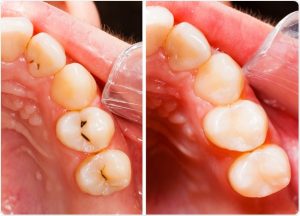What Exactly Is A Cavity?
Our teeth are covered with a hard protective layer called enamel. Once the enamel is weakened by acids produced by bacteria from foods left on teeth, a pit or cavity is formed in or on the tooth surface. Cavities are usually formed as a result of inadequate brushing and flossing and/or a high sugar and acidic diet. Decay happens over time and is the softening of the enamel.
Stages Of Tooth Decay
As you will read below, arresting tooth decay in the earliest stages is most cost effective and will also save your teeth. The Stages of Tooth Decay are:
Stage 1: White Spots. The first stage of tooth decay begins when chalky white areas on the surface of the tooth appear due to the loss of calcium and build-up of plaque. …
Stage Two: Enamel Decay
Stage Three: Dentin Decay
Stage Four: Involvement of the Pulp
Stage Five: Abscess Formation
Stage Six: Tooth Loss

Treating Dental Decay
Your dentist will be able to see decay on your teeth with a visual examination and dental xrays. When dental caries or decay is found on the teeth, your dentist will be able to see how advanced the decay is. From here we will be able to see if a simple filling will suffice. In some cases, if the decay is advanced it may be close the pulp of the tooth and may require root canal treatment or removal of that tooth.
For a simple filling, the dentist will make sure you are very comfortable and usually give you a small amount of local anesthetic. Once the anesthetic has been administered, your dentist will then begin to remove all of the softened and decayed enamel. The dentist will be making sure all of the decay is thoroughly removed leaving no bacteria or active decay behind.

The next step is to layer the white filling material into the cleaned out cavity or pit. Each layer will be carefully placed and set with a curing light. Once the cavity is filled and light cured, your dentist will ensure the filling is fitting into your bite by making you clench gently on a soft piece of articulating paper.
Once your bite feels and looks right, the final restoration is polished to be smooth and aesthetically pleasing.
Should your dentist find that the decay has reached the deeper part of your tooth – root canal therapy or extraction may be discussed.


















